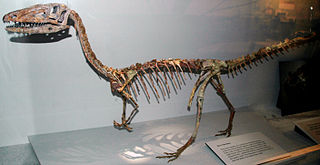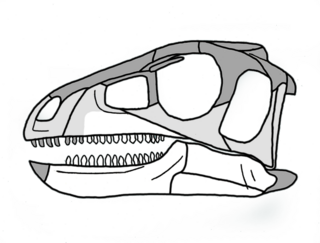
Coelophysis is a genus of coelophysid theropod dinosaur that lived approximately 215 to 208.5 million years ago during the Late Triassic period from the middle to late Norian age in what is now the southwestern United States. Megapnosaurus was once considered to be a species within this genus, but this interpretation has been challenged since 2017 and the genus Megapnosaurus is now considered valid.

Thecodontosaurus is a genus of herbivorous basal sauropodomorph dinosaur that lived during the late Triassic period.

Abrictosaurus is a genus of heterodontosaurid dinosaur that lived during the Early Jurassic in what is now in parts of southern Africa such as Lesotho and South Africa. It was a bipedal herbivore or omnivore and was one of the most basal heterodontosaurids. It was approximately 1.2 metres (3.9 ft) long and weighed between 0.68 and 3 kilograms.
Eucoelophysis is a genus of silesaurid dinosauriform from the Late Triassic (Norian) period Chinle Formation of New Mexico. It was assumed to be a coelophysid upon description, but a study by Nesbitt et al. found that it was actually a close relative of Silesaurus, which was independently supported by Ezcurra (2006), who found it to be the sister group to Dinosauria, and Silesaurus as the next most basal taxon.

Aetosaurs are heavily armored reptiles belonging to the extinct order Aetosauria. They were medium- to large-sized omnivorous or herbivorous pseudosuchians, part of the branch of archosaurs more closely related to crocodilians than to birds and other dinosaurs. All known aetosaurs are restricted to the Late Triassic, and in some strata from this time they are among the most abundant fossil vertebrates. They have small heads, upturned snouts, erect limbs, and a body ornamented with four rows of plate-like osteoderms. Aetosaur fossil remains are known from Europe, North and South America, parts of Africa, and India. Since their armoured plates are often preserved and are abundant in certain localities, aetosaurs serve as important Late Triassic tetrapod index fossils. Many aetosaurs had wide geographic ranges, but their stratigraphic ranges were relatively short. Therefore, the presence of particular aetosaurs can accurately date a site in which they are found.

Revueltosaurus is an extinct genus of suchian pseudosuchian from Late Triassic deposits of New Mexico, Arizona and North Carolina, United States. Many specimens, mostly teeth, have been assigned to Revueltosaurus over the years. Currently, three species are included in this genus, all of which were originally thought to represent monospecific genera of basal ornithischian dinosaurs. It was 1 meter long.
Caseosaurus is a dubious genus of saurischian dinosaur that lived approximately 221.5 to 212 million years ago during the latter part of the Triassic Period in what is now Texas, in North America. It was a small, lightly-built, bipedal, ground-dwelling carnivore, and could grow up to 2 m (6.6 ft) long.

Camposaurus is a coelophysid dinosaur genus from the Norian stage of the Late Triassic period of North America. The pertinent fossil remains date back to the early to middle Norian stage, and is widely regarded as the oldest known neotheropod.

Crosbysaurus is a genus of extinct archosauromorph that lived in the Late Triassic of Arizona, New Mexico, North Carolina, Texas, and Utah. It is known from the Chinle Formation and Dockum Group rock units from the southwestern United States. The type species is C. harrisae, and the only known material includes teeth. 11 specimens are known, each including a single tooth.
Technosaurus is an extinct genus of Late Triassic silesaurid dinosauriform, from the Late Triassic Cooper Canyon Formation of Texas, United States.
Spinosuchus is an extinct genus of trilophosaurid allokotosaur from the Late Triassic of Texas, southern United States. It has been assigned to a variety of groups over its history, from coelophysid dinosaur to pseudosuchian to uncertain theropod dinosaur and to Proterosuchidae. This uncertainty is not unusual, given that it was only known from a poorly preserved, wall-mounted, partial vertebral column of an animal that lived in a time of diverse, poorly known reptile groups. However, newly collected material and recent phylogenetic studies of early archosauromorphs suggest that it represents an advanced trilophosaurid very closely related to Trilophosaurus.
Krzyzanowskisaurus is the name given to a genus of archosaur from the Late Triassic-aged Chinle Formation and it is a tooth taxon, based on fossils only of teeth and these teeth have been found in the U.S. states of Arizona and New Mexico. The original report described it as a "probable ornithischian" and Heckert (2005) suggests that Krzyzanowskisaurus teeth have biostratigraphic utility as an index fossil of the St. Johnsian sub-LVF.

Pisanosaurus is an extinct genus of early dinosauriform, likely an ornithischian or silesaurid, from the Late Triassic of Argentina. It was a small, lightly built, ground-dwelling herbivore, that could grow up to an estimated 1 m (3.3 ft) long. Only one species, the type, Pisanosaurus mertii, is known, based on a single partial skeleton discovered in the Ischigualasto Formation of the Ischigualasto-Villa Unión Basin in northwestern Argentina. This part of the formation has been dated to the late Carnian, approximately 229 million years ago.
Lucianosaurus is an extinct genus of amniote of unknown affinities, known only from teeth. Initially described as a basal ornithischian dinosaur, subsequently reclassified as a member of the clade Archosauriformes of uncertain phylogenetic placement and later, taking into account the similarity of its teeth to the teeth of traversodontid cynodonts such as Dadadon, as an amniote of uncertain affinities.
Suchoprion is a dubious genus of phytosaurian archosaur known from poor remains from the Late Triassic of North America. It was once thought to be a theropod dinosaur until 2013, when it was reclassified as a phytosaur.

Dinosauromorpha is a clade of avemetatarsalian archosaurs that includes the Dinosauria (dinosaurs) and some of their close relatives. It was originally defined to include dinosauriforms and lagerpetids, with later formulations specifically excluding pterosaurs from the group. Birds are the only dinosauromorphs which survive to the present day.

Machaeroprosopus is an extinct genus of mystriosuchin leptosuchomorph phytosaur from the Late Triassic of the southwestern United States. M. validus, once thought to be the type species of Machaeroprosopus, was named in 1916 on the basis of three complete skulls from Chinle Formation, Arizona. The skulls have been lost since the 1950s, and a line drawing in the original 1916 description is the only visual record of the specimen. Another species, M. andersoni, was named in 1922 from New Mexico, and the species M. adamanensis, M. gregorii, M. lithodendrorum, M. tenuis, and M. zunii were named in 1930. Most species have been reassigned to the genera Smilosuchus, Rutiodon, or Phytosaurus. Until recently, M. validus was considered to be the only species that has not been reassigned. Thus, Machaeroprosopus was considered to be a nomen dubium or "doubtful name" because of the lack of diagnostic specimens that can support its distinction from other phytosaur genera. However, a taxonomic revision of Machaeroprosopus, conducted by Parker et al. in 2013, revealed that UW 3807, the holotype of M. validus, is not the holotype of Machaeroprosopus, while the species Machaeroprosopus buceros, Machaeroprosopus being a replacement name, with a fixed type species, for Metarhinus, is the combinatio nova of the type species of the genu: Belodon buceros. Therefore, the name Pseudopalatus must be considered a junior synonym of Machaeroprosopus, and all species of the former must be reassigned to the latter. This revised taxonomy was already accepted in several studies, including Stocker and Butler (2013). Stocker and Butler (2013) also treated M. andersoni as a valid species, and not a junior synonym of Machaeroprosopus buceros as was previously suggested by Long and Murry (1995).

Paleontology in Pennsylvania refers to paleontological research occurring within or conducted by people from the U.S. state of Pennsylvania. The geologic column of Pennsylvania spans from the Precambrian to Quaternary. During the early part of the Paleozoic, Pennsylvania was submerged by a warm, shallow sea. This sea would come to be inhabited by creatures like brachiopods, bryozoans, crinoids, graptolites, and trilobites. The armored fish Palaeaspis appeared during the Silurian. By the Devonian the state was home to other kinds of fishes. On land, some of the world's oldest tetrapods left behind footprints that would later fossilize. Some of Pennsylvania's most important fossil finds were made in the state's Devonian rocks. Carboniferous Pennsylvania was a swampy environment covered by a wide variety of plants. The latter half of the period was called the Pennsylvanian in honor of the state's rich contemporary rock record. By the end of the Paleozoic the state was no longer so swampy. During the Mesozoic the state was home to dinosaurs and other kinds of reptiles, who left behind fossil footprints. Little is known about the early to mid Cenozoic of Pennsylvania, but during the Ice Age it seemed to have a tundra-like environment. Local Delaware people used to smoke mixtures of fossil bones and tobacco for good luck and to have wishes granted. By the late 1800s Pennsylvania was the site of formal scientific investigation of fossils. Around this time Hadrosaurus foulkii of neighboring New Jersey became the first mounted dinosaur skeleton exhibit at the Academy of Natural Sciences in Philadelphia. The Devonian trilobite Phacops rana is the Pennsylvania state fossil.
The Bull Run Formation is a Late Triassic (Norian) stratigraphic unit in the eastern United States. Fossil fish bones and scales have been found in outcrops of the formation's Groveton Member in Manassas National Battlefield Park. Indeterminate fossil ornithischian tracks have been reported from the formation.










